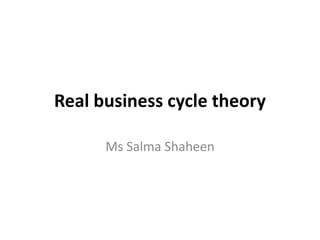
Lecture
- 1. Real business cycle theory Ms Salma Shaheen
- 2. Real business cycle theory • Real business cycle theory (RBC theory) are a class of macroeconomic models in which business cycle fluctuations to a large extent can be accounted for by real (in contrast to nominal) shocks. • Unlike other leading theories of the business cycle, RBC theory sees recessions and periods of economic growth as the efficient response to exogenous changes in the real economic environment.
- 3. • That is, the level of national output necessarily maximizes expected utility, and government should therefore concentrate on the long-run structural policy changes and not intervene through discretionary fiscal or monetary policy designed to actively smooth out economic short-term fluctuations.
- 4. The Theory of Real Business Cycles • All prices are flexible, even in short run: – thus, money is neutral, even in short run. – classical dichotomy holds at all times • Fluctuations in output, employment, and other variables are the optimal responses to exogenous changes in the economic environment. • Productivity shocks are the primary cause of economic fluctuations.
- 5. • Economy consists of a single producer-consumer, like Robinson Crusoe on a desert island. • Crusoe divides his time between – leisure – Working • Crusoe optimizes given the constraints he faces • The shocks are not always desirable. But once they occur, fluctuations in output, employment, and other variables are the optimal responses to them
- 6. • The labor market • Intertemporal substitution of labor: In RBC theory, workers are willing to reallocate labor over time in response to changes in the reward to working now versus later. • The intertemporal relative wage equals 1 2 (1 )r W W
- 7. • where W1 is the wage in period 1 (the present) and W2 is the wage in period 2 (the future). • In RBC theory, – shocks cause fluctuations in the intertemporal relative wage – workers respond by adjusting labor supply – this causes employment and output to fluctuate • Critics argue that – labor supply is not very sensitive to the intertemporal real wage – high unemployment observed in recessions is mainly involuntary
- 8. • Technology shocks • In RBC theory, economic fluctuations are caused by productivity shocks. • Solow residual: a measure of productivity shocks, shows the change in output that cannot be explained by changes in capital and labor. • RBC theory implies that the Solow residual should be highly correlated with output.
- 9. The neutrality of money • RBC critics note that reductions in money growth and inflation are almost always associated with periods of high unemployment and low output. • RBC proponents respond by claiming that the money supply is endogenous: – Suppose output is expected to fall. Central bank reduces money supply in response to an expected fall in money demand.
- 10. . Wage and price flexibility • RBC theory assumes that wages and prices are completely flexible, so markets always clear. • RBC proponents argue that the degree of price stickiness occurring in the real world is not important for understanding economic fluctuations. • RBC proponents also assume flexible prices to be consistent with microeconomic theory. • Critics believe that wage and price stickiness explains involuntary unemployment and the non-neutrality of money.
